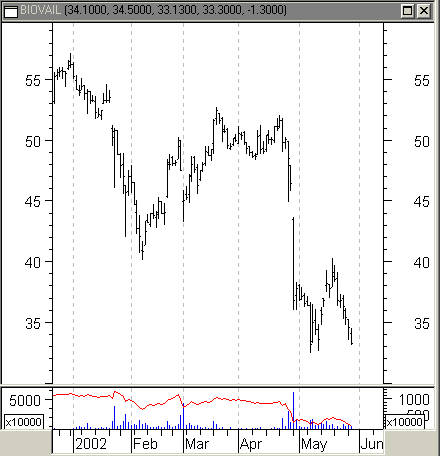
HOT TOPICS LIST
- MACD
- Fibonacci
- RSI
- Gann
- ADXR
- Stochastics
- Volume
- Triangles
- Futures
- Cycles
- Volatility
- ZIGZAG
- MESA
- Retracement
- Aroon
INDICATORS LIST
LIST OF TOPICS
PRINT THIS ARTICLE
by David Penn
The diamond at the bottom of the decline in the S&P Pharmaceuticals Index could mean reversal. But further declines are more likely.
Position: N/A
David Penn
Technical Writer for Technical Analysis of STOCKS & COMMODITIES magazine, Working-Money.com, and Traders.com Advantage.
PRINT THIS ARTICLE
SECTOR INVESTING
Diamonds in the Rough for the Drug Sector
05/30/02 01:58:38 PMby David Penn
The diamond at the bottom of the decline in the S&P Pharmaceuticals Index could mean reversal. But further declines are more likely.
Position: N/A
| I don't know if it was the cover of last week's Economist magazine, which featured a chillingly hairless androgynous face behind a headline that read "The Future of Mind Control," or the report in the Wall Street Journal recently that suggested that fully two-thirds of the prescription drugs approved by the FDA over the last 12 years were "identical to existing drugs or modified versions," but the pharmaceuticals industry has taken a real thrashing in the markets in 2002. Down 12% year-to-date, the S&P Pharmaceuticals Index reached a year-to-date peak in mid-March along with the broader market, before losing 15% to fall to its current position. |
 The S&P Pharmaceuticals have spent most of May in a diamond-shaped consolidation, as the first chart shows. Diamond consolidations can be either reversal patterns or continuation patterns, depending on the breakout/down direction. The diamond in this Index looks only to be a few days away from a move in either direction. Fortunately, breakouts from diamonds tend to move up and away from the formation relatively quickly; use any break of the trendlines that form the upper right and lower right sides of the diamond as a guide toward which direction prices are likely to continue moving. |

|
| Graphic provided by: MetaStock. |
| |
| One way of determining whether or not the S&P Pharmaceuticals Index diamond is a bottom formation or a reversal formation is by looking at some of the component stocks. If few of the component stocks look as if they are forming bottoms, then it is unlikely that the Index that represents them is establishing a bottom. In this case, a look at one of the major pharmaceuticals, Pfizer (PFE), underscores the weakness in the industry. If anything, Pfizer looks to be breaking down in late May, as its consolidation range between 35.5 and 37.5 gives way to piercing corrections. |
 Biovail (BVF) is another pharmaceutical that well-illustrates the problems the industry has had in the spring of 2002. Biovail, as the chart shows, has a sharp rally following its correction in April, but that rally gives way almost immediately. In fact, there is no consolidation in May for Biovail. This suggests that Biovail, relative to the rest of the pharmaceuticals, may be more volatile, particularly on the downside--given the stock's recent trading history. |
 Is there a bullish case to be made for the pharmaceuticals? There are some major pharmaceuticals that have been performing well this spring. Novaris (NVS) is up a whopping 83% year-to-date and AmerisourceBergen Corporation (ABC) is up 24% YTD. Other stocks, such as Pharmacia (PHA) and Pharmaceutical Resources (PRX) are rallying toward tests of their April highs. But the near-term outlook for individual pharmaceutical stocks--from GlaxoSmithKline to King Pharmaceuticals--remains worrisome. And a downside breakout from the S&P Pharmaceuticals Index would only confirm that anxiety. |
Technical Writer for Technical Analysis of STOCKS & COMMODITIES magazine, Working-Money.com, and Traders.com Advantage.
| Title: | Technical Writer |
| Company: | Technical Analysis, Inc. |
| Address: | 4757 California Avenue SW |
| Seattle, WA 98116 | |
| Phone # for sales: | 206 938 0570 |
| Fax: | 206 938 1307 |
| Website: | www.Traders.com |
| E-mail address: | DPenn@traders.com |
Traders' Resource Links | |
| Charting the Stock Market: The Wyckoff Method -- Books | |
| Working-Money.com -- Online Trading Services | |
| Traders.com Advantage -- Online Trading Services | |
| Technical Analysis of Stocks & Commodities -- Publications and Newsletters | |
| Working Money, at Working-Money.com -- Publications and Newsletters | |
| Traders.com Advantage -- Publications and Newsletters | |
| Professional Traders Starter Kit -- Software | |
Click here for more information about our publications!
PRINT THIS ARTICLE

|

Request Information From Our Sponsors
- StockCharts.com, Inc.
- Candle Patterns
- Candlestick Charting Explained
- Intermarket Technical Analysis
- John Murphy on Chart Analysis
- John Murphy's Chart Pattern Recognition
- John Murphy's Market Message
- MurphyExplainsMarketAnalysis-Intermarket Analysis
- MurphyExplainsMarketAnalysis-Visual Analysis
- StockCharts.com
- Technical Analysis of the Financial Markets
- The Visual Investor
- VectorVest, Inc.
- Executive Premier Workshop
- One-Day Options Course
- OptionsPro
- Retirement Income Workshop
- Sure-Fire Trading Systems (VectorVest, Inc.)
- Trading as a Business Workshop
- VectorVest 7 EOD
- VectorVest 7 RealTime/IntraDay
- VectorVest AutoTester
- VectorVest Educational Services
- VectorVest OnLine
- VectorVest Options Analyzer
- VectorVest ProGraphics v6.0
- VectorVest ProTrader 7
- VectorVest RealTime Derby Tool
- VectorVest Simulator
- VectorVest Variator
- VectorVest Watchdog
